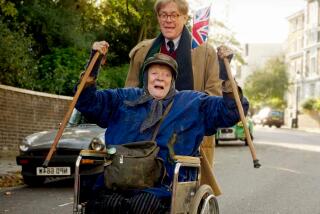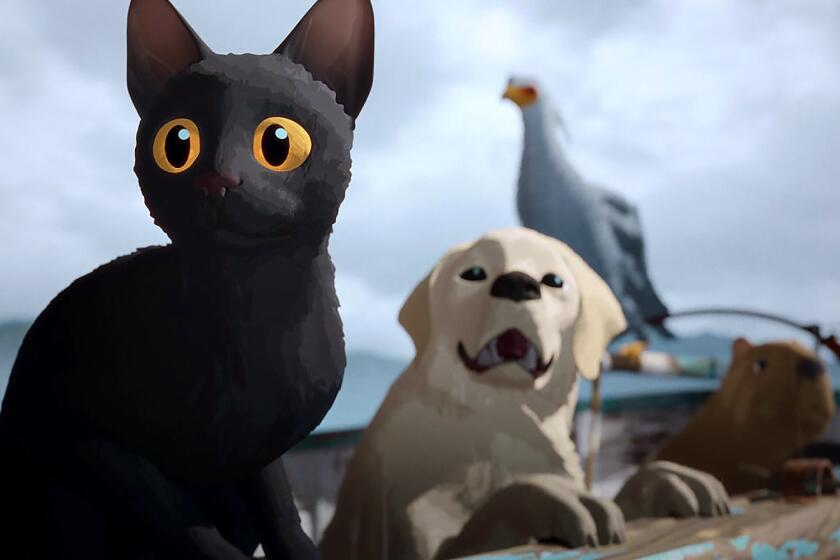A Difference of Style--and of Substance
Photos of Diana Vreeland are on display in the lobby of the Coronet Theatre, where “Full Gallop”--a show about the fashion empress--is playing.
The vintage images reveal a woman with a thin face, a prominent nose and a slender figure not unlike those of the glamorous models who surrounded her.
A few steps away, Brenda Vaccaro plays Vreeland. Vaccaro has a round face, an unobtrusive nose and a more robust figure. Though her hair and makeup are styled to resemble Vreeland’s, the photos underline the differences.
But looks shouldn’t matter so much, right? Vreeland might have disagreed. As an editor of Harper’s Bazaar, then Vogue, from 1938 to 1971, she lived in a world of appearances, and much of the script of “Full Gallop” is devoted to her exclamations over how various people or objects look.
On the other hand, she also says, “I don’t give a damn about ‘authentic,’ if it’s ugly.” Maybe she wouldn’t care about the authenticity of her depiction in “Full Gallop,” as long as it made her look beautiful. Sure enough, this show celebrates Vreeland as one of the beautiful people, worthy of coverage by her own magazines.
If that’s where the play stops, however--and it is--why dramatize Vreeland’s story? Drama usually depends on glimpsing people when they’re not at their most photogenic, on examining conflicts that arise in people’s lives.
“Full Gallop” is far from a full drama. Although it purports to depict Vreeland at an ebb tide, soon after she was fired from Vogue, we don’t feel her pain. After losing her job, she supposedly fled to Europe for four glorious months, and now she’s back in her New York apartment to seek new professional adventures--which, we soon realize, won’t take long to show up.
Here, Vreeland prowls the stage, spouting one-liners and recalling observations and incidents from her past, more or less at random, with no discernible arc. She dabbles with the tango for a moment, she occasionally issues orders to an offstage assistant, but at only one point does she modulate her volume and vivacity in order to remember something sad. There is so little variation in tone that it becomes a terribly static evening.
This problem often afflicts celebrity monologues. Perhaps the static quality is more appropriate here than it is for many other subjects of such shows, for the stream of chitchat resembles the contents of the magazines Vreeland edited. But one can always set aside a copy of Vogue; it’s more problematic to leave a two-hour public event.
This appeared not to bother critics of earlier productions of “Full Gallop,” which premiered at the Old Globe Theatre in San Diego in 1995. But those productions starred the co-writer of the script, Mary Louise Wilson, who--from all reports--looks much more like Vreeland than does Vaccaro and who must have immersed herself in the details of Vreeland’s life for a long time, along with co-writer Mark Hampton.
Surprisingly few of those details made it into the script--there is less information about Vreeland in this show than in a chapter about her in the book “The Power of Style,” distributed to members of the press though not to other audience members. Still, presumably Wilson’s performance carried with it a spark of the real thing.
The original director, Nicholas Martin, also directed Vaccaro, who certainly knows flamboyance. But Vaccaro’s style is derived more from all-American brassiness than from continental hauteur (Vreeland was born in France and lived there as a child). Vaccaro’s voice usually sounds husky and on the verge of breaking. Was Vreeland this loud and hoarse?
At the press preview, Vaccaro appeared to hesitate halfway through the parsing of some of her lines, as if she hadn’t quite thought them through. And in one case, a male prompter’s voice suddenly was heard, feeding her a line.
James Noone’s set is a festival of reds, marred by cabinets that look oddly downscale and the intermittent reflection of David E. Segal’s lights off the top of an ice bucket, straight into the eyes of some theatergoers.
Vaccaro looks elegant in her black and gray outfit, designed by Mary Malin; Vreeland tells us that “black is the hardest color in the world to get right, except for gray.” But in a show that’s so much about fashion, one expects--but does not get--a costume change at intermission.
* “Full Gallop,” Coronet Theatre, 366 N. La Cienega Blvd., Los Angeles. Dark tonight. Regular schedule: Tuesdays-Saturdays, 8 p.m.; Sundays, 7 p.m.; Saturdays-Sundays, 3 p.m. Ends May 24. $38-$42.50. (310) 657-7377, (213) 365-3500). Running time: 2 hours.
More to Read
The biggest entertainment stories
Get our big stories about Hollywood, film, television, music, arts, culture and more right in your inbox as soon as they publish.
You may occasionally receive promotional content from the Los Angeles Times.










